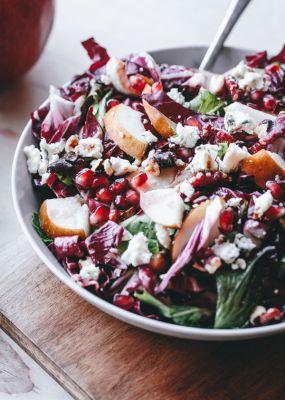Pulmonary fibrosis is an uncommon chronic lung disease that impacts a small percentage of adults later in life. For those living with pulmonary fibrosis, a persistent cough and periods of breathlessness can take a major toll over time. One of the easiest ways to manage your symptoms and improve your quality of life is to ensure you feed your body the proper nutrients. Deciding to follow a pulmonary fibrosis diet is a good place to start.
What Is Pulmonary Fibrosis?
Pulmonary fibrosis is a type of interstitial lung disease that worsens over time. It’s associated with scarring and thickening of the lung tissue, which makes it increasingly difficult to breathe. The elasticity of the lungs slowly deteriorates and loses the ability to expand, resulting in impaired gas exchange. This eventually starves the body of oxygen and creates a multitude of other health-related problems.
As the name implies, the cause of idiopathic pulmonary fibrosis is unknown, but several contributing factors have been identified that make certain people more susceptible to the disease. The most common causes and risk factors include:
- Advancing age (diagnosis between age 40-70)
- Medications (antibiotics, cardiac medicines, chemotherapy drugs)
- Recreational or work-related environmental exposures to dust, fumes, etc.
- Smoking
- Connective tissue disorders
- Male gender
- Genetics
- Viral infections (Epstein-Barr, hepatitis C, influenza, herpes simplex)
- History of heartburn (GERD)
Unfortunately, a cure has yet to be identified, and the post-diagnosis survival rate is grim at three to five years.
Signs and Symptoms
Many pulmonary fibrosis patients may be asymptomatic in the early stages, but most experience a number of signs and symptoms over the course of the disease that can easily be mistaken for other respiratory diseases.
The most common include:
- Shortness of breath with exertion initially and eventually at rest
- Dry or hacking cough
- Chest discomfort or pain
- Fatigue
- Malaise
- Loss of appetite resulting in weight loss
- Muscle and joint aches and pains
- Clubbing of the fingers or toes (widening and rounding due to poor oxygen exchange)
- Swelling of the lower extremities
The severity of symptoms can make this condition unbearable at times, but proper nutrition has proven beneficial for improving pulmonary fibrosis symptoms.
Pulmonary Fibrosis Diet
A pulmonary fibrosis diet doesn’t have to be complicated. In fact, it’s very similar to the Food Pyramid Guide the U.S. Department of Agriculture (USDA) rolled out in the early ‘90s that outlined serving suggestions of the major food groups. Still, some special considerations need to be made for people with pulmonary fibrosis.
Since appetite fluctuations can lead to unexplained weight loss over time, people with pulmonary fibrosis should try to eat five to seven smaller meals a day every two to three hours instead of three big meals and a snack. Eating smaller meals will take less effort and should keep you satisfied until your next meal or snack.
Dietary changes may be necessary to ensure your diet is low in saturated and trans fats, sodium and cholesterol, and doesn’t contain a lot of added sugar, which follows the same dietary guidelines suggested to prevent heart disease, obesity and cancer. Increasing your water intake should also be a major priority because it can help thin secretions and make coughs more productive.
Finally, the National Heart, Lung and Blood Institute recommends choosing foods from these eight major food categories to help improve pulmonary fibrosis symptoms:
1. Lean Protein
According to the USDA, lean protein should contain less than 10 grams of total fat with 45 percent or fewer grams in the form of saturated fat and less than 95 milligrams of cholesterol per 3.5-ounce serving. Keep in mind that a lot of protein sources meet this requirement, but a good pulmonary fibrosis diet targets specific choices such as:
- Fatty fish (salmon, tuna, sardines, mackerel, trout)
- Chicken breast without skin
- Eggs
- Beans
- Peas
If this list seems limited, feel free to get creative with different spices or herbs to keep things appetizing.
2. Vegetables
Vegetables should be considered before fruits when managing pulmonary fibrosis symptoms. Consuming a colorful variety of vegetables is best because each of them contains different antioxidants, minerals, and vitamins that provide numerous health benefits. Plus, they can help you meet your daily fiber goal. Some of the best choices to include on a revolving basis are:
- Bell peppers
- Carrots
- Celery
- Leafy greens (arugula, broccoli, Brussel sprouts, cabbage, collard greens, kale, spinach)
- Squash
- Sweet Potatoes
Vegetable juices, such as beet, cactus, carrot and tomato juice, can also be a great alternative.
3. Fruit
Fruit offers many health benefits as well. Fresh and frozen fruit is best, but canned may be used in a pinch. Just like vegetables, every variety of fruit is loaded with a different combination of antioxidants, vitamins and minerals, and all of them are good sources of fiber, which helps the body function at its optimum level. The most commonly recommended fruits for pulmonary fibrosis include:
- Citrus fruits (grapefruit, oranges, lemons, limes)
- Bananas
- Berries
- Cantaloupe
- Cherries
- Kiwi
- Mangos
- Pineapple
Fruit juices can also be added, but these should be consumed in moderation. Some examples include orange, lemon and cranberry juice. Consider experimenting with various fruits and vegetables to make nutrient-packed smoothies.
4. Low-Fat or Fat-Free Dairy Products
Dairy products have been given a bad rap over the years when it comes to chronic lung diseases. In the past, milk was incorrectly blamed for causing increased mucus production, but this claim was proven to be unfounded.
The same can be said for the other suggested dairy products included on this list:
- Milk
- Yogurt (Regular or Greek)
- Cheese
- Kefir
- Powdered milk
- Non-dairy alternatives
- Almond milk
- Soy milk
- Veggie cheese
The caloric benefits of this food group are why it’s highly recommended for people with pulmonary fibrosis.
5. Whole Grains
Whole grains come in a variety of forms and are praised for their nutrient and fiber-rich content. Eating whole grains can make you feel fuller faster and for longer, which is extremely beneficial for pulmonary fibrosis patients who struggle to with appetite loss. Some of the most commonly recommended whole grain foods include:
- Barley
- Breads and cereals
- Brown rice
- Oatmeal
- Popcorn
- Quinoa
- Wild rice
Whole grains offer additional benefits as well. For example, besides helping with digestion, whole grains can help lower cholesterol levels and even reduce inflammation, which can be a concern for patients with chronic lung diseases.
6. Nuts and Seeds
Nuts and seeds are a valuable protein source in addition to containing a number of vitamins, minerals and healthy fats. The best nuts and seeds for this diet are:
- Almonds
- Walnuts
- Chia seeds
- Flaxseed
Nuts and seeds are also a good source of fiber, so they’ll help fill you up, which can be a challenging proposition for some people with pulmonary fibrosis.
7. Healthy Fats
Healthy fats are classified as either monounsaturated or polyunsaturated fats. Some recommended healthy fats include Omega-3s, Omega-6s and several oil varieties, including olive, hemp and flaxseed. These fats are beneficial to people with pulmonary fibrosis primarily due to their ability to reduce bad (LDL) cholesterol.
8. Nutritional Shakes
Nutritional shakes — such as Atkins, Boost, Carnation, Ensure and Special K — can be a convenient way for people with pulmonary fibrosis to fill nutritional gaps throughout the day. They come in a variety of flavors, and some have added protein, vitamins and minerals. You can also look for shakes that contain systemic enzymes; these supplements have been shown in some studies to improve symptoms of pulmonary fibrosis.
Conclusion
Pulmonary fibrosis can be a tough disease to live with and manage, but there are things you can do to improve your symptoms. Eating a healthy, pulmonary fibrosis-approved diet is a great starting point. You may be pleasantly surprised how even minor changes can make a noticeable difference over time. Since everyone reacts differently, experiment to see which dietary combinations offer you the most symptom relief.



![women [longevity live]](https://longevitylive.com/wp-content/uploads/2020/01/photo-of-women-walking-down-the-street-1116984-100x100.jpg)










